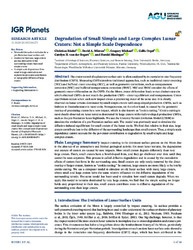Degradation of Small Simple and Large Complex Lunar Craters: Not a Simple Scale Dependence
DOI: https://doi.org/10.1029/2019JE006273
Persistent URL: http://resolver.sub.uni-goettingen.de/purl?gldocs-11858/8511
Persistent URL: http://resolver.sub.uni-goettingen.de/purl?gldocs-11858/8511
Riedel, Christian; Minton, David A.; Michael, Gregory; Orgel, Csilla; van der Bogert, Carolyn H.; Hiesinger, Harald, 2020: Degradation of Small Simple and Large Complex Lunar Craters: Not a Simple Scale Dependence. In: Journal of Geophysical Research: Planets, Band 125, 4, DOI: 10.1029/2019JE006273.
 |
Dokument öffnen: |
The crater record of a planetary surface unit is often analyzed by its cumulative size‐frequency distribution (CSFD). Measuring CSFDs involves traditional approaches, such as traditional crater counting (TCC) and buffered crater counting (BCC), as well as geometric corrections, such as nonsparseness correction (NSC) and buffered nonsparseness correction (BNSC). NSC and BNSC consider the effects of geometric crater obliteration on the CSFD. On the Moon, crater obliteration leads to two distinct states in which obtained CSFDs do not match the production CSFD—crater equilibrium and nonsparseness. Crater equilibrium occurs when each new impact erases a preexisting crater of the same size. It is clearly observed on lunar terrains dominated by small simple craters with steep‐sloped production CSFDs, such as Imbrian to Eratosthenian‐era mare units. Nonsparseness, on the other hand, is caused by the geometric overlap of preexisting craters by a new impact, which is also known as “cookie cutting.” Cookie cutting is most clearly observed on lunar terrains dominated by large craters with shallow‐sloped production CSFDs, such as the pre‐Nectarian lunar highlands. We use the Cratered Terrain Evolution Model (CTEM) to simulate the evolution of a pre‐Nectarian surface unit. The model was previously used to simulate the diffusion‐induced equilibrium for small craters of the lunar maria. We find that relative to their size, large craters contribute less to the diffusion of the surrounding landscape than small craters. Thus, a simple scale dependence cannot account for the per‐crater contribution to degradation by small simple and large complex craters. Plain Language Summary:
Impact cratering is the dominant surface process on the Moon due to the absence of an atmosphere and limited geological activity. On most lunar terrains, the degradation and erasure of craters are caused by new impacts. Most small craters degrade differently than very large craters. Fresh, small craters have a bowl‐shaped form, and they get shallower over time until they cannot be seen anymore. This process is called diffusive degradation and is caused by the cumulative effects of craters that form in the surrounding area. Small craters are only rarely removed by the direct overlap of larger craters, known as “cookie cutting.” In contrast, large craters are more likely to be lost by cookie cutting. We use a computer model to simulate an old lunar surface with many large craters, where small and large craters have the same relative influence on the diffusive degradation of the surrounding terrain. The same model has been used to simulate how small craters degrade. When we apply this model to terrains dominated by very large craters, we find that the simple scaling no longer holds and, proportional to their size, small craters contribute more to diffusive degradation of the surrounding area than large craters. Key Points:
We model the surface evolution for a pre‐Nectarian lunar surface unit.
Relative to their size, large craters are less destructive to the surrounding terrain than small simple craters.
A simple scale dependence from small to large craters does not explain the per‐crater contribution to topographic diffusion of large craters.
Statistik:
ZugriffsstatistikSammlung:
This is an open access article under the terms of the Creative Commons Attribution License, which permits use, distribution and reproduction in any medium, provided the original work is properly cited.

